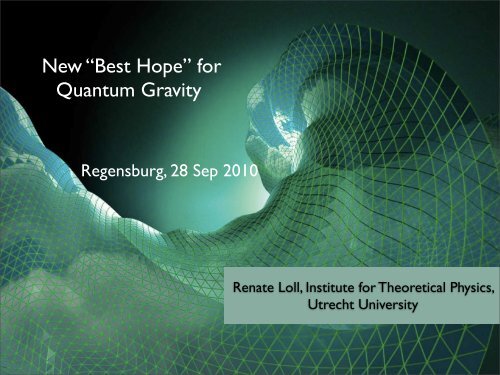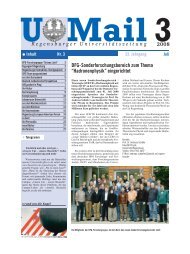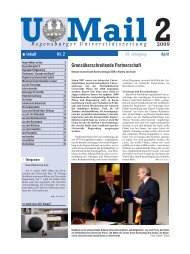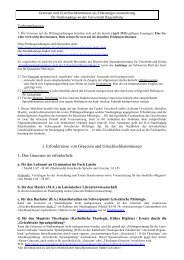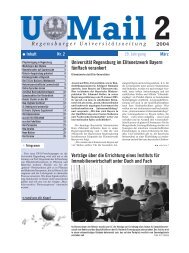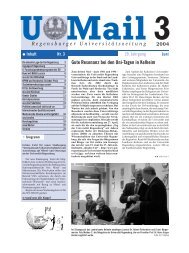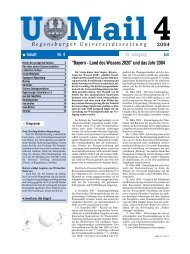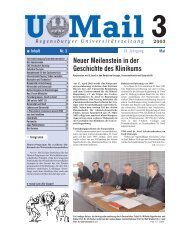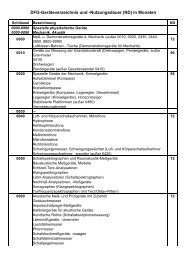New “Best Hope” for Quantum Gravity
New “Best Hope” for Quantum Gravity
New “Best Hope” for Quantum Gravity
You also want an ePaper? Increase the reach of your titles
YUMPU automatically turns print PDFs into web optimized ePapers that Google loves.
<strong>New</strong> <strong>“Best</strong> <strong>Hope”</strong> <strong>for</strong><br />
<strong>Quantum</strong> <strong>Gravity</strong><br />
Regensburg, 28 Sep 2010<br />
Renate Loll, Institute <strong>for</strong> Theoretical Physics,<br />
Utrecht University
Does <strong>Quantum</strong> <strong>Gravity</strong> really exist?<br />
• there is no direct evidence, and little “phenomenology”<br />
• gravity is very weak; perhaps it need not be quantized? (still, would need<br />
to show consistency)<br />
On the other hand,<br />
• gravity is universal (and everything else is quantized)<br />
• there exist situations where gravity is strong and short distances are<br />
involved (big bang, black hole singularities)<br />
Perhaps the question is ill posed? What d.o.f. “take over” at the Planck<br />
scale (pre-geometry, spacetime foam, ...)?<br />
Let us agree to call this “quantum gravity”<br />
too, and let us assume that something like<br />
quantum gravity indeed exists, “grandly<br />
unified” or otherwise.<br />
Spacetime Foam?
<strong>Quantum</strong> <strong>Gravity</strong> from Causal Dynamical Triangulation<br />
(QG from CDT)<br />
CDT is a no-frills nonperturbative implementation of the gravitational path<br />
integral, much in the spirit of lattice quantum field theory, but based on<br />
dynamical lattices, reflecting the dynamical nature of spacetime geometry.<br />
The key result that has put QG from CDT on<br />
the map as a serious contender <strong>for</strong> a quantum<br />
theory of gravity is the fact that it can generate<br />
dynamically a sensible semiclassical background<br />
geometry from pure quantum excitations, in an<br />
a priori background-independent <strong>for</strong>mulation.<br />
This has so far not been achieved in any other<br />
approach to quantum gravity.<br />
(PRL 93 (2004) 131301, PRD 72 (2005) 064014, PLB 607 (2005) 205)<br />
my report here concerns joint work with J. Ambjørn, A. Görlich, S. Jordan,<br />
J. Jurkiewicz, I. Khavkine and P. Reska
Basic tool: the path integral<br />
Textbook example: the nonrelativistic particle in one dimension<br />
<strong>Quantum</strong> superposition principle: the transition amplitude from xi(ti)<br />
to xf(tf) is given as a weighted sum over amplitudes exp iS[x(t)] of all<br />
possible trajectories, where S[x(t)] is the classical action of the path.<br />
(here, time is discretized in steps of length a, and the trajectories are piecewise linear)
The same superposition principle, applied to gravity<br />
By ev.$;cit_ cor^stnrhor4 r t ritI glr
A key input in dynamical triangulations<br />
approximating classical curved<br />
surfaces through triangulation<br />
triangulation = regularization<br />
N.B.: no coordinates!<br />
A typical path<br />
integral history<br />
(2d quantum gravity)<br />
<strong>Quantum</strong> Theory: approximating the space of all<br />
curved geometries by a space of triangulations -<br />
one needs to integrate over this space ( * ) !<br />
( * ) by Monte Carlo simulations (<strong>for</strong> CDT models in d=2, 3 have also exact stat. mech.<br />
solutions methods, see e.g. D. Benedetti, F. Zamponi, R.L., PRD 76 (2007) 104022; in<br />
d=2, the problem becomes purely combinatorial)
Making sense of the path integral via causal dynamical<br />
(..tlhaf<br />
ts.-CDT-.@<br />
5ot<br />
gace-t-they'g.v<br />
^ll<br />
2f s<br />
AUW\ Ovef tni6to!^ies<br />
r'5* c?)<br />
curved sgacetih^e-<br />
3eo\^/\atr9 Z<br />
Ie@<br />
.- n .<br />
"- x-lhn<br />
cDT' q,->o<br />
H<br />
CDT<br />
etSutar,<br />
N -too<br />
triangulations<br />
rr<br />
z<br />
9f?tv I tr4 .<br />
vT<br />
A Ltqx<br />
^\<br />
r /\/ :<br />
itrcquiv.<br />
+riaigul.5<br />
Te j.,u<br />
1<br />
Ccr )<br />
\<br />
i sR%' Lr)<br />
e-<br />
lArt cr) t<br />
gturng,T<br />
+tl 6!*Ci..t ,^<br />
c?'lffiF,fi "W<br />
-+?tL<br />
o oorks directtg o,^.<br />
?ace-<br />
.t f{%st tr<br />
gQr-elries<br />
. rtorn,perfurbattve: gs <strong>for</strong> awog {r.^^ dass. Elementary four-simplex, building block<br />
<strong>for</strong> a causal dynamical triangulation:<br />
Sd.S<br />
(a o ~ boeXrour,rd. edge length, - diffeomorphism-<br />
iwd.egende^t- , " d,gr-ocfz\cg of e,,<br />
"<br />
invariant o UV regulator)<br />
@vt euz.[ur.fe- 7 qua^l-i ]aft veliy<br />
o t^^iwl h^a\isl- l\^if ed,lC^,rtS<br />
I<br />
‘democratic’, regularized<br />
sum over piecewise flat<br />
spacetimes, doesn’t need<br />
coordinates; continuum<br />
limit required to obtain<br />
‘universal’ results<br />
independent of the<br />
regularization<br />
CDT’s proper-time slicing
Where are we in the universe of candidate theories<br />
of quantum gravity?<br />
The CDT approach is based on the premise that the framework of standard<br />
quantum field theory is sufficient to construct and understand quantum gravity as a<br />
fundamental theory. The dynamical, causal and nonperturbative nature of spacetime<br />
must be taken into account properly, but no “exotic” ingredients are needed.<br />
A similar philosophy underlies also the application of the exact renormalization<br />
group to gravity, which tries to verify S. Weinberg’s asymptotic safety scenario.<br />
Intriguingly, another key result of CDT,<br />
that of “dynamical dimensional reduction”<br />
near the Planck scale (PRL 95 (2004)<br />
171301) has also been corroborated in<br />
this approach (M.Reuter, O. Lauscher,<br />
DS Σ<br />
S EH = 1<br />
<br />
d 4 x − det g(R[g, ∂g, ∂ 2 JHEP 0510:050, 2005), as well as in<br />
“Lifshitz gravity” (P. Hořava, PRL 102<br />
g] − 2Λ)<br />
GN<br />
(2009) 161301), a completely different<br />
QFT-based approach to quantum gravity. 500 1000 1500 2000 2500 3000 Σ<br />
2<br />
2.5<br />
4<br />
3.5<br />
3<br />
classical spacetime manifold<br />
quantum spacetime generated by CDT<br />
spectral dimension DS(σ) as function of diffusion time σ
Wick rotation and analogy with statistical mechanics<br />
each regularized Lorentzian geometry T allows <strong>for</strong> a rotation to a unique<br />
regularized Euclidean geometry Teu, such that the Feynman amplitude of a path<br />
is turned into a Boltzmann weight, as in statistical mechanics<br />
this turns the quantum amplitude Z into a partition function Zeu and allows<br />
one to use powerful numerical methods from statistical mechanics, like Monte<br />
Carlo simulations<br />
a ‘classical trajectory’ is an average over quantum trajectories in the<br />
statistical ensemble of trajectories (the Euclideanized ‘sum over histories’)<br />
taking the continuum limit of this regularized theory means to study the<br />
critical behaviour of the underlying statistical theory<br />
S EH = 1<br />
<br />
d 4 x − det g(R[g, ∂g, ∂ 2 g] − 2Λ)<br />
per<strong>for</strong>ming an ‘inverse GN Wick rotation’ on quantities computed in the<br />
continuum limit is in general nontrivial<br />
e iSRegge (T )<br />
→ e<br />
−S Regge<br />
eu (Teu)
The phase diagram of Causal Dynamical Triangulations<br />
λ<br />
!<br />
4<br />
crit<br />
4<br />
! λ (! ,") 0<br />
B<br />
"<br />
C<br />
!<br />
0<br />
λ ~ cosmological constant<br />
κ0 ~ 1/GN inverse <strong>New</strong>ton’s<br />
constant<br />
Δ ~ relative time/space scaling<br />
c ~ numerical constant, >0<br />
Ni ~ # of triangular building<br />
blocks of dimension i<br />
The partition function is defined <strong>for</strong> λ > λ crit (κ0,Δ);<br />
approaching the critical surface = taking infinite-volume limit.<br />
red lines ~ phase transitions<br />
A<br />
S Regge<br />
eu<br />
= −κ0N2 + N4(cκ0 + λ) +<br />
+∆(2N (4,1)<br />
4<br />
(J. Ambjørn, J. Jurkiewicz, RL, PRD 72 (2005) 064014;<br />
J. Ambjørn, A. Görlich, S. Jordan, J. Jurkiewicz, RL, PLB 690 (2010) 413)<br />
+ N (3,2)<br />
4 )
What is the extended universe emergent in phase C?<br />
<br />
10000<br />
9000<br />
8000<br />
7000<br />
6000<br />
5000<br />
4000<br />
3000<br />
2000<br />
1000<br />
0<br />
in red: size of typical<br />
quantum fluctuations<br />
K0 = 2.200000, ! = 0.600000, K4 = 0.925000, Vol = 160k<br />
-1000<br />
-40 -30 -20 -10 0 10 20 30 40<br />
The volume profile , as function of Euclidean proper time t=iτ, perfectly<br />
matches that of a Euclidean de Sitter space, with scale factor a(t) 2 ,<br />
ds 2 = dt 2 + a(t) 2 dΩ 2 (3) = dt2 + c 2 cos 2<br />
t<br />
Monte Carlo<br />
Fit, a sin<br />
a = 8253<br />
3 cos (t/b)<br />
MC, <br />
t<br />
c<br />
b = 14.371<br />
w = 7.5353<br />
<br />
dΩ 2 (3)<br />
(J. Ambjørn, A. Görlich, J. Jurkiewicz, RL, PRL 100 (2008) 091304,<br />
PRD 78 (2008) 063544))<br />
volume el. S 3
Remarkably, having started from the Wick-rotated path integral,<br />
<br />
D[g] e −Seu , Seu =<br />
S EH = 1<br />
GN<br />
<br />
<br />
dt (− ˙ V 2<br />
3<br />
V3<br />
− V 1/3<br />
3<br />
+ . . . )<br />
by integrating out everything but the global scaling mode V3(t), we obtain an<br />
effective dynamics <strong>for</strong> V3(t), given by<br />
e −Seff<br />
eu , S eff<br />
eu =<br />
<br />
dt (+ ˙ V 2<br />
3<br />
V3<br />
+ V 1/3<br />
3<br />
+ . . . )<br />
This is entirely due to nonperturbative, entropic effects (the PI measure).<br />
Expanding the minisuperspace action around the de Sitter solution,<br />
Seu(V3) = S(V dS<br />
3 ) + κ<br />
<br />
dt δV3(t) ˆ HδV3(t)<br />
the eigenmodes of ˆH match well with those extracted from the simulations:<br />
0.1<br />
20 10 10 20<br />
0.1<br />
0.2<br />
0.3<br />
d 4 x − det g(R[g, ∂g, ∂ 2 g] − 2Λ)<br />
0.2<br />
0.1<br />
20 10 10 20<br />
0.1<br />
0.2<br />
0.3<br />
(N.B.: no further<br />
fitting necessary)
CDT - fresh from the press<br />
studying matter coupling (influence of matter on geometry, extract<br />
<strong>New</strong>ton’s law, the early universe coupled to a scalar field) -<br />
we have recently been able to quantify the expected effect of a single<br />
pointlike mass on the volume profile of CDT’s de Sitter background<br />
(I. Khavkine, P. Reska, RL, Class. Quant. Grav. 27 (2010) 185025)<br />
establishing a functional relation with the renormalization group flows of<br />
studies of the ‘asymptotic safety scenario’ (J. Ambjørn, A. Görlich, J. Jurkiewicz,<br />
RL, to appear), verify/falsify the existence of a UV fixed point<br />
analyze the phase structure of QG from CDT, establish order of critical<br />
transition lines/points (J. Ambjørn, A. Görlich, S. Jordan, J. Jurkiewicz, RL, PLB<br />
690 (2010) 413, and in preparation)<br />
S EH = 1<br />
<br />
d<br />
GN<br />
4 x − det g(R[g, ∂g, ∂ 2 investigating short-scale quantum structure of spacetime, and coming up<br />
with an effective description of Planckian dynamics - g] we − 2Λ) have recently<br />
analyzed the fractality of the quantum geometry by using geodesic shell<br />
decompositions (J. Ambjørn, A. Görlich, J. Jurkiewicz, RL, PLB 690 (2010) 420)
Causal Dynamical Triangulations - Summary & Outlook<br />
CDT is a path integral <strong>for</strong>mulation of gravity, which encorporates the<br />
dynamical and causal nature of geometry. Its associated toolbox provides us<br />
with an “experimental lab” - a nonperturbative calculational handle on<br />
(near-)Planckian physics (c.f. lattice QCD).<br />
We have begun to make quantitative statements/predictions.<br />
We can also test nonperturbative predictions from other fundamental<br />
theories containing gravity.<br />
Many nonperturbative lessons learned so far: emergence of<br />
classicality from quantum dynamics; dynamical nature of “dimension”<br />
on short scales; “time” and “causality” are fundamental, and not<br />
merely emergent, macroscopic properties of spacetime.<br />
S EH = 1<br />
GN<br />
<br />
All of this corroborates our best hope. - Watch this space!<br />
d 4 x − det g(R[g, ∂g, ∂ 2 g] − 2Λ)
Where to learn more<br />
• CDT light: “The self-organizing quantum universe”, by J. Ambjørn,<br />
J. Jurkiewicz, RL (Scientific American, July 2008)<br />
• A reasonably nontechnical review in Contemp. Phys. 47 (2006)<br />
[arxiv: hep-th/0509010]<br />
• recent reviews: arXiv 0906.3947, 1004.0352, 1007.2560<br />
• links to both review and popular science material can be found on<br />
my homepage http://www.phys.uu.nl/~loll<br />
S EH = 1<br />
GN<br />
<br />
d 4 x − det g(R[g, ∂g, ∂ 2 g] − 2Λ)
<strong>New</strong> <strong>“Best</strong> <strong>Hope”</strong> <strong>for</strong><br />
<strong>Quantum</strong> <strong>Gravity</strong><br />
Regensburg, 28 Sep 2010<br />
The End


